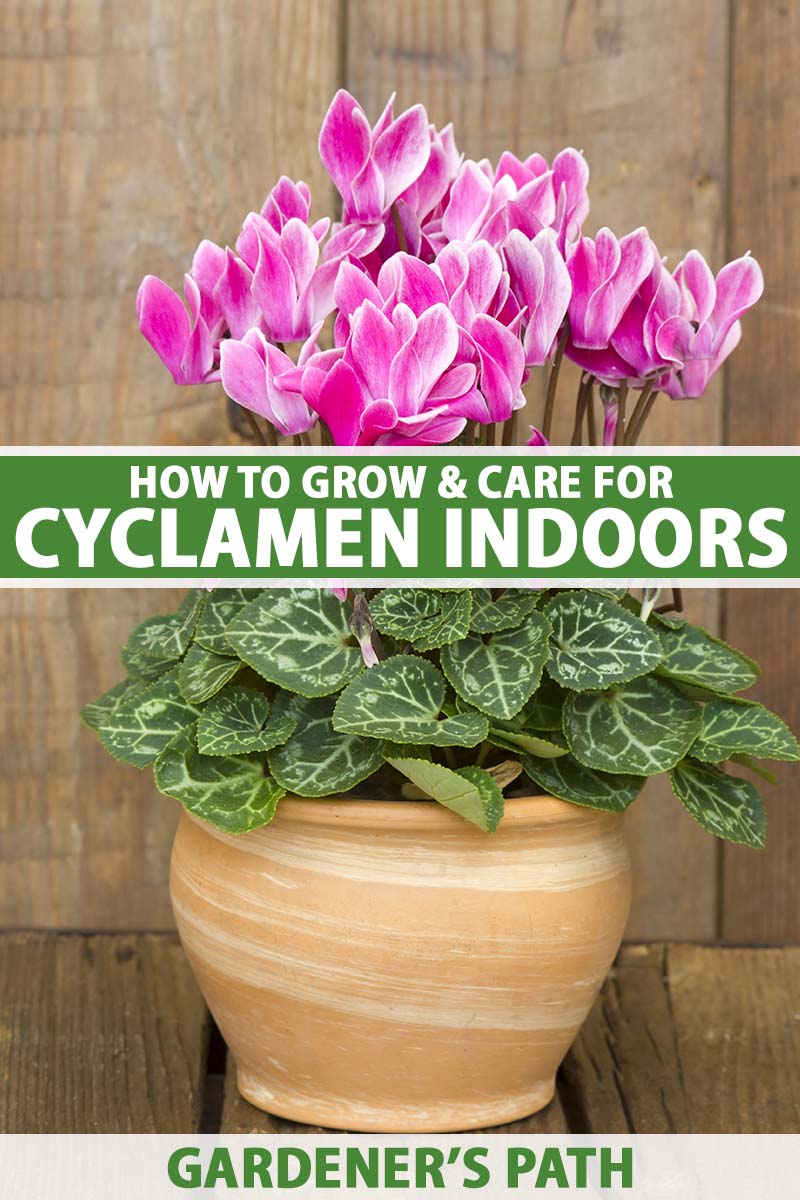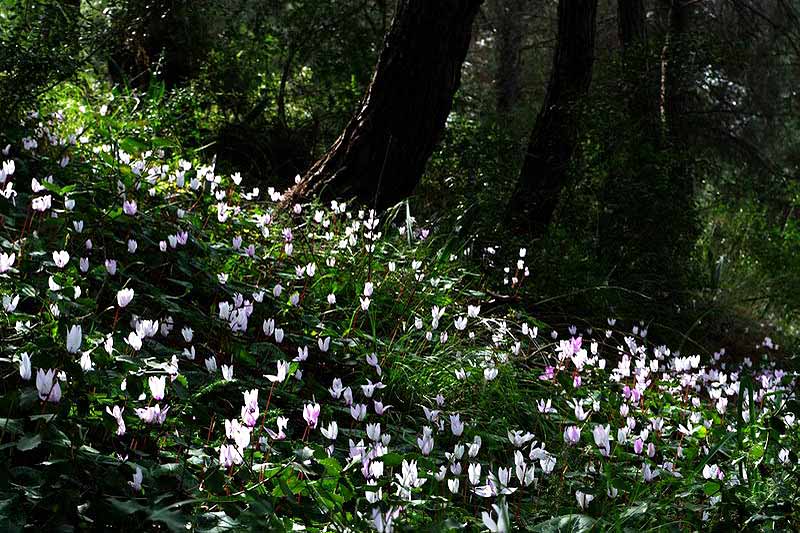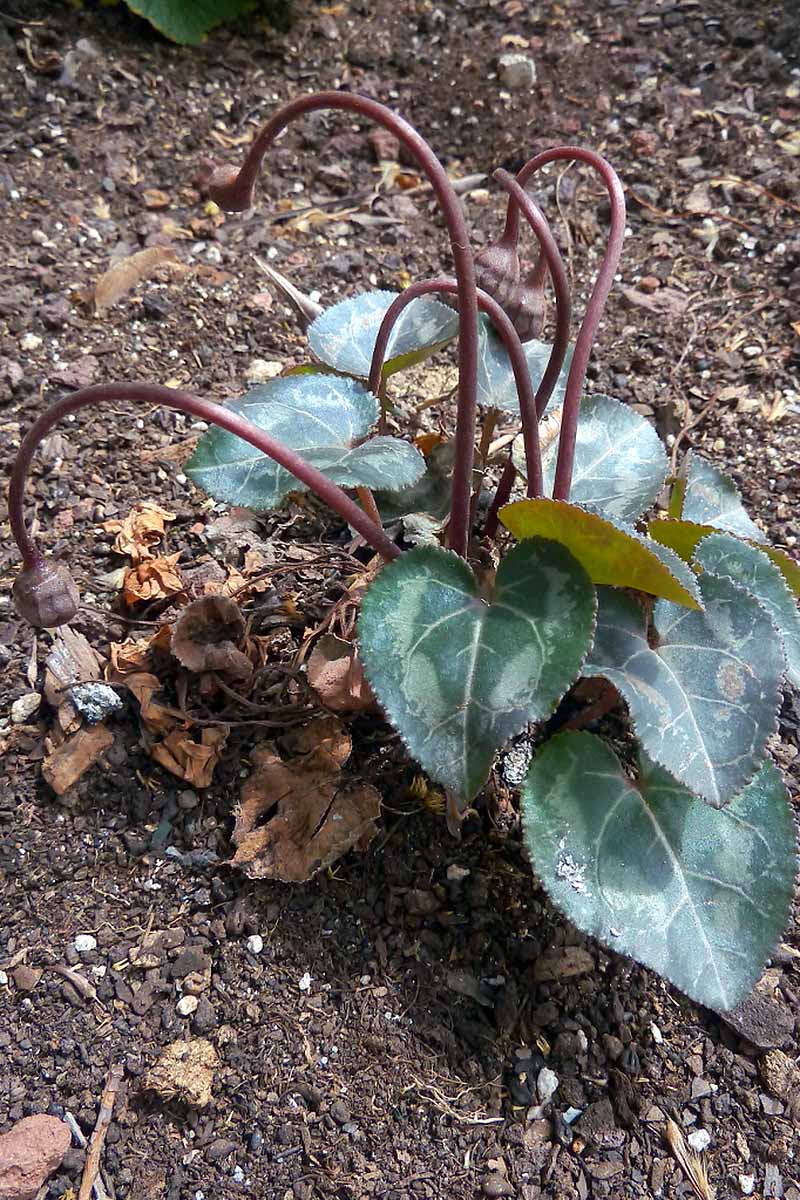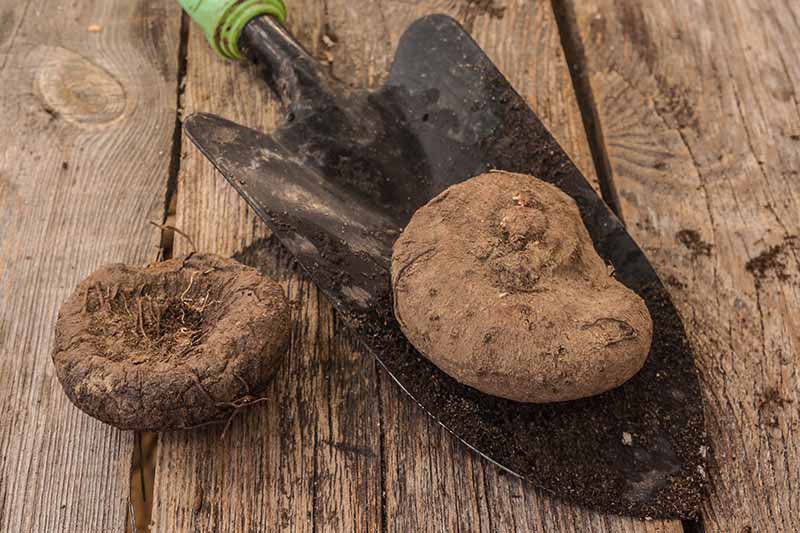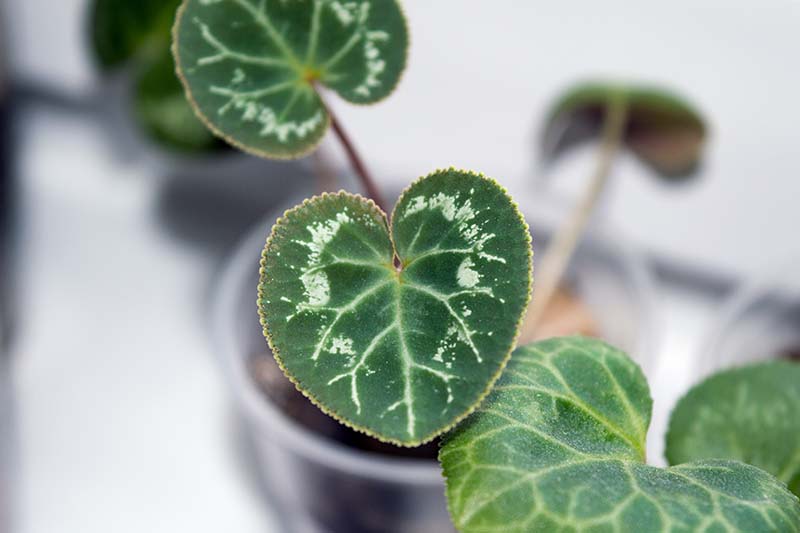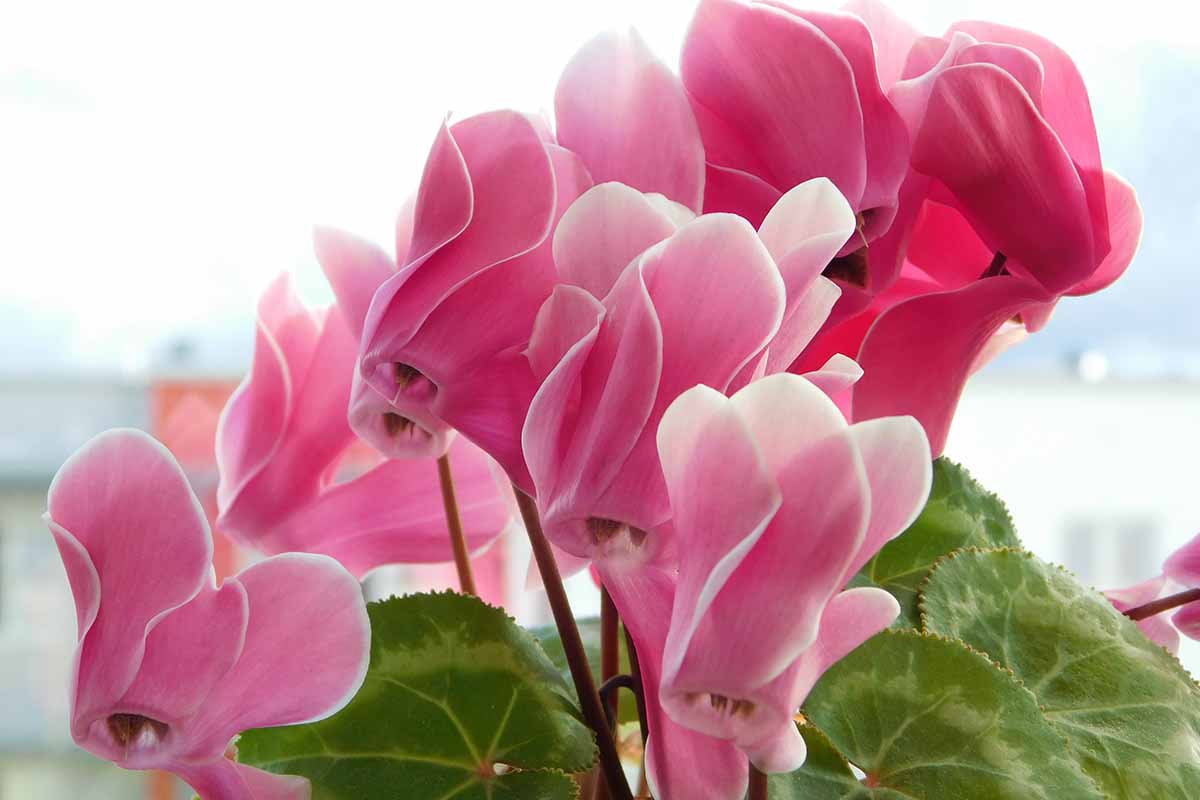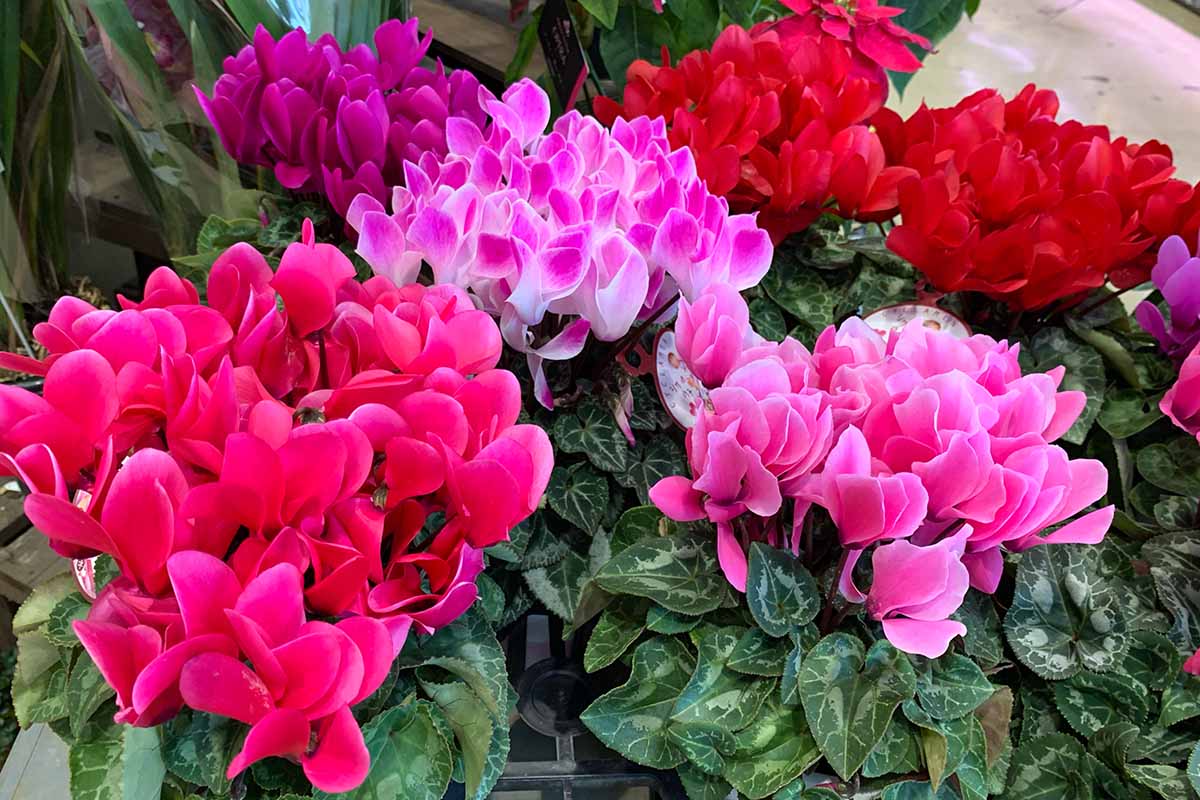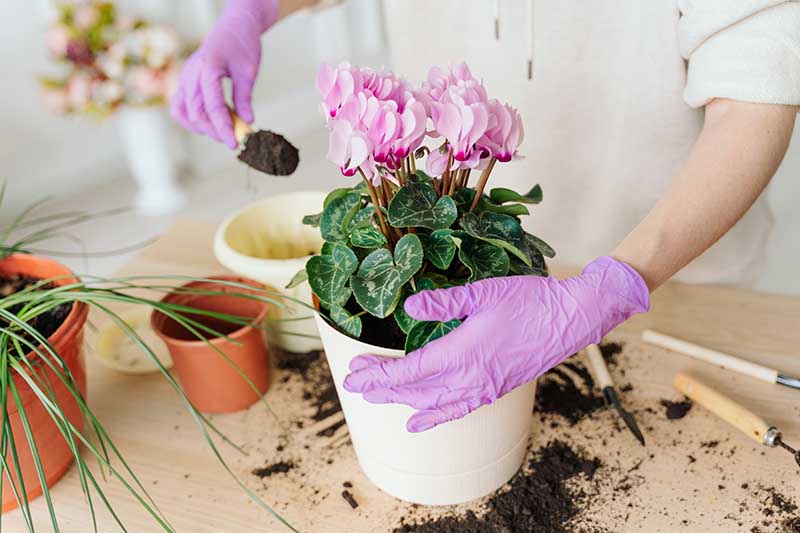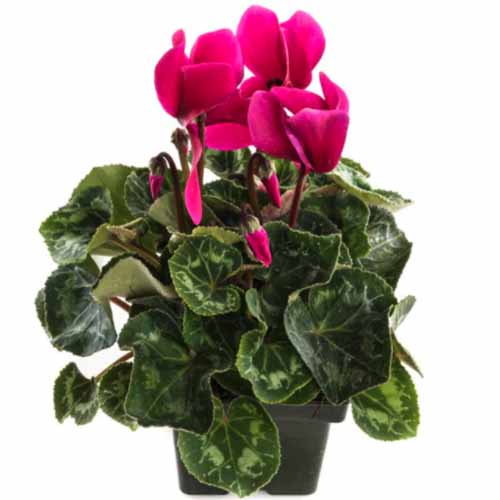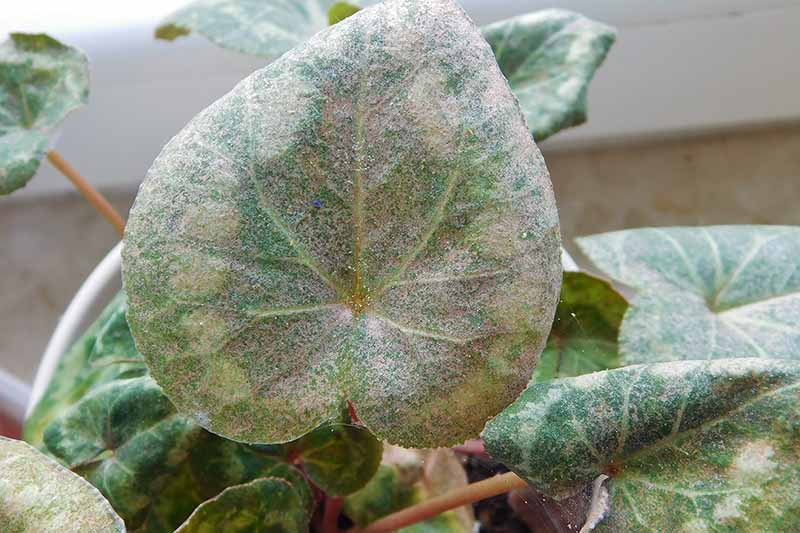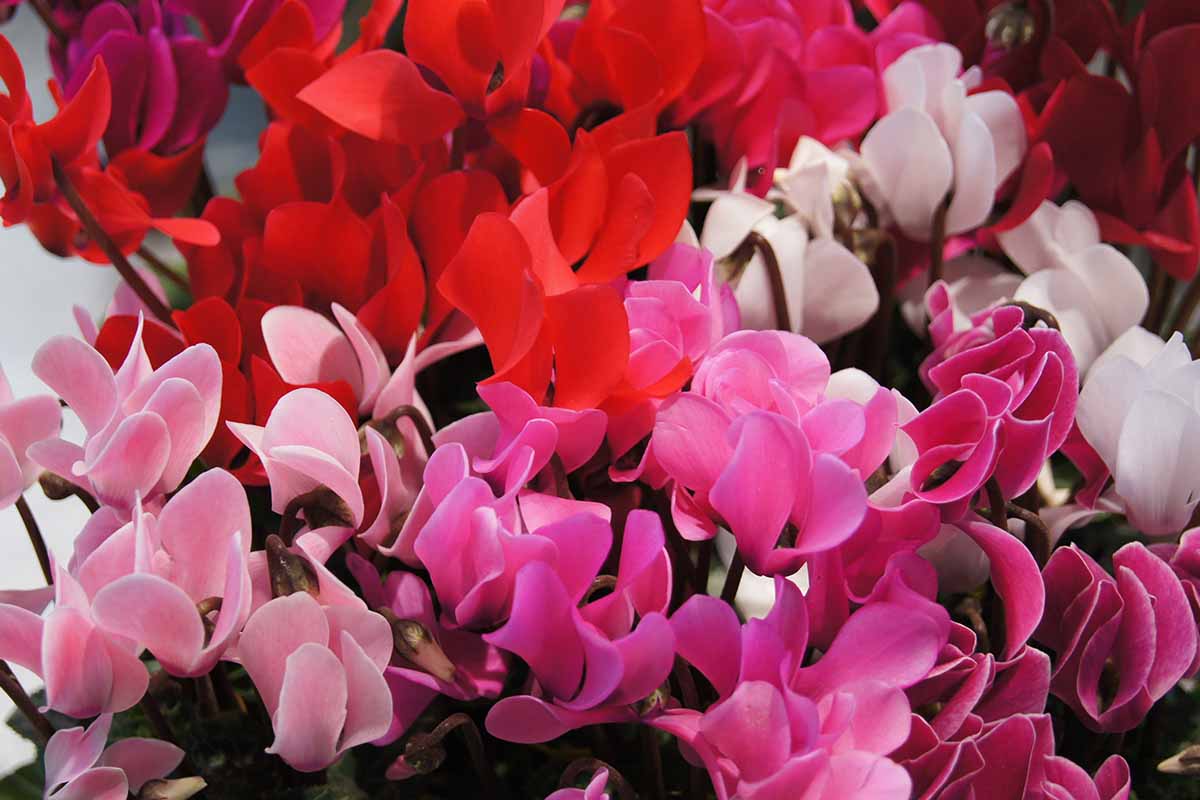Native to the Mediterranean region, it grows well outdoors in USDA Hardiness Zones 9 to 11, and potted up indoors in all zones. Hybridized, or cross-bred varieties of this species are incredibly popular winter gifts that make up a sizable chunk of the multi-billion-dollar floral industry’s holiday market share, alongside the poinsettia and Christmas cactus. We link to vendors to help you find relevant products. If you buy from one of our links, we may earn a commission. In this article, we’ll discuss growing and caring for a cyclamen indoors so it lasts well beyond the holiday season. Here’s what we’ll cover: Before we get started, please note that cyclamen is toxic to pets and people, and should not be consumed.
Cultivation and History
C. persicum is a frost-tender perennial that grows from a round tuber that is commonly, but erroneously, referred to as a corm. It prefers a moderate amount of humidity, daytime temperatures ranging from 60 to 65°F, and nighttime temperatures above 50°F. In its natural habitat, it’s part-shade understory flora found along rocky coasts, peeking out from crevices and spreading in glorious drifts. Here it enjoys a growing environment with moderate winter humidity and moist, fertile, well-draining soil with a slightly acidic to neutral pH of 6.0 to 7.0. Indoors, it needs bright, indirect sunlight and loose, airy potting soil that is both well-draining and moisture-retentive. Too much sun can cause overheating and scorching, and oversaturation is its nemesis, quickly leading to rotting. In early winter, heart-shaped foliage sprouts. It is either solid green or green with silver markings. Next come sturdy, upright, leafless flower stems that soon bud and open. After three to four months of blooming, seed capsules may form (though not all hybrids set seed), the foliage fades and withers, and summer dormancy begins. When autumn comes, the life cycle begins again. There are references to cyclamen dating as far back as Greek antiquity. Also known as Christmas or florist cyclamen, this species does not come from Persia, as its original name would suggest. Per the Culham Research Group, this misnomer likely originated as 17th-century vernacular for a species with geographic origins that may have been somewhat misunderstood. There has been much debate in modern times about the species’ proper botanical classification. It has been added to and removed from the primrose family since 1952. In 2009, it was returned and there it remains. Species C. persicum has been extensively cultivated for the floral industry for over 150 years. The development of intraspecific hybrids has led to advancements like a shorter time from seed to maturity, stronger plants, larger flowers, bolder hues, petal variations, lower light requirements, and greater heat tolerance, as well as both earlier and later bloom times. On the downside, hybrids may produce no seed, non-viable seed, or seed with traits that differ from those of the parents. And some cultivated varieties lack the sweet scent of the wild species. With some background under our belts, let’s find out how to begin.
Propagation
As mentioned, cyclamen does set seed. However, today’s holiday offerings are hybrids, so don’t get your hopes up for seed collecting. With viable seed sown by summer’s end, you should see flowers by the second winter. Some of the early-blooming cultivars may bloom even sooner. Propagating tubers, and growing seedlings and nursery transplants, are other viable options for propagation.
From Dormant Tubers
You can start with a bare, dormant tuber – but first you’ll have to find one! With a huge market for holiday-ready pots, cyclamen corms aren’t a grower’s cash cow, especially in zones where it doesn’t grow outdoors. To start with a tuber, select a clean container with good drainage that can attractively accommodate the mature dimensions of your selected variety. The species average is six to nine inches tall and wide, although there are “mini” cultivars that top out at three to six inches, and “magnum” types that reach 10 to 14 inches. Allow for an extra inch of diameter for easy watering. Fill the pot three-quarters full with a good quality potting soil. It should be light and airy, moisture retentive, and well-draining. Make a depression in the soil about an inch deep, and settle the corm into it. Barely cover the tuber with soil, leaving it clearly visible, as you would with an iris rhizome. Avoid planting it too deeply, as this can lead to rotting. Tamp the soil firmly around it. Water the soil around the perimeter of the container, rather than over the tuber, until it drips through the drainage hole. Water again to ensure thorough saturation. Apply a liquid flowering houseplant food diluted to half-strength over the perimeter soil. Set the pot in a location with a cool temperature of 60 to 65°F, where the sunlight is bright and indirect. Avoid placements directly in front of windows, as intense light through glass may cause the foliage to scorch. Alternatively, you can sow a corm in a smaller container and transplant it once it has at least two leaves, per the instructions below. A note on dividing tubers: I don’t recommend dividing tender indoor cyclamen, as it has enough challenges growing in a pot and not under its familiar outdoor conditions. Cyclamen tubers may produce offsets that can be snipped away from the mother and planted as described above. However, the cut may make the plant vulnerable to moisture penetration and rotting. Some folks propagate theirs by slicing a section off the mother that contains a growing point, or “eye.” This technique may also promote rotting. Let’s turn our attention to a less stressful way to begin.
From a Seedling or Nursery Transplant
For a young plant with two leaves or more that was started from a seed or tuber, or for a nursery plant, select a container with good drainage that can accommodate the mature dimensions, as we did above. Unpot and set the plant in the new container at the same depth it was in the original one, using a good-quality potting medium to settle it at the right height. Fill in all around it with more potting medium and tamp it down. Water around the edges of the container, avoiding the leaves. Repeat watering to collapse any air pockets. Note that wet leaves may lead to rotting and are to be avoided. Feed with half-strength liquid flowering houseplant food as above. Set the pot in a room with a temperature of approximately 65°F and bright, indirect sunlight.
How to Grow
Once propagated, cyclamen requires regular care. As it is prone to rotting, it benefits from watering only when the soil is completely dry. Use a moisture meter to help gauge when water is needed. An alternative method to watering around the edge of the soil is to stand the container in a pan of water and let it soak up moisture through its drainage hole, a technique called bottom watering. Take care to remove it from the pan after it’s had its fill, or the pot may oversaturate. Here again, a moisture meter comes in handy. Another consideration is the moisture in the air. Indoor humidity usually falls between 30 and 50 percent. Increasing the ambient humidity near flora is easily done in one of two ways: Place other houseplants in close proximity, so the moisture they generate collectively from transpiration, or the evaporation of water, can moisten them all. Or, here’s a more labor-intensive method. Place a rust-proof pan containing a layer of pea gravel beneath a potted cyclamen. By barely covering the gravel with water, the moisture around the pot increases as the water evaporates. However, note that if the water is too deep, the drainage hole will draw water up into the soil, and may prevent adequate drainage. Perpetual wetness may lead to rotting. In addition to proper watering, plant food is beneficial during the time leading up to blooming. Choose a liquid houseplant fertilizer formulated for flowering plants that has an NPK (nitrogen-phosphorus-potassium) ratio that is lower in nitrogen than the other two nutrients. It will support optimal flower production without promoting excess foliar growth. Dilute the fertilizer with water to half strength, and apply it every two weeks from the time shoots appear until blooming starts. Suspend feeding during blooming and dormancy. Resume when next year’s shoots appear. At this point, are you wondering why cyclamen grown indoors needs bright, indirect sunlight, while outdoors it grows in part shade? This is a great question! I’ll do my best to explain. In its native Mediterranean climate, C. persicum blooms during the winter, the time of year when the trees are lush with foliage and sunlight is filtered down to the understory where they live. Winter is also the time of year when the most rain falls, increasing the humidity beneath that leafy canopy, but draining well through the sandy loam of the coastal landscape. In the summertime, conditions are very warm and dry. The trees drop their leaves and the cyclamen finish blooming, wither, die back, and go dormant. To replicate this natural cycle indoors, home gardeners need to provide an abundance of bright light that is indirect, as though it was being filtered through Mediterranean trees, to avoid causing severe overheating, drying, and scorching during the blooming season. By summer, an indoor cyclamen finishes flowering and withers, leaving no trace of life behind above the soil level. It’s no wonder that many folks toss the apparent carcass in the trash, or onto the compost heap at this point! But guess what? Contrary to what may be popular belief, cyclamen can live for years with a little TLC, because the corm is still very much alive! We’ll cover how to care for your plant as a perennial in the pruning and maintenance section of the article below.
Growing Tips
Caring for a potted cyclamen is easy with the following:
Potting medium that is airy, moisture-retentive, and well-draining.Bright indirect sunlight.A dose of liquid flowering houseplant food at planting/transplanting time and every two weeks during the growing season.A thorough drenching when the soil completely dries out.Remember to avoid wetting the flowers and foliage to inhibit bacterial/fungal growth and rotting, and consider bottom watering as an alternative.Do not water during dormancy.
Pruning and Maintenance
After your plant finishes blooming, do not toss it in the trash! It’s easy to keep cyclamen feeling and looking its best. Deadhead as blooms fade by twisting or snipping off spent blooms as close to the bottom of the stem as possible. Remove dead or damaged foliage in the same manner. At season’s end, remove and discard all wilted and dried foliage either in the trash or on the compost heap, and rest assured that the plant is not dead! Discontinue watering during summer dormancy. Some folks mist once or twice during dormancy, but it’s unnecessary. Per Susan Mahr of the University of Wisconsin Madison Horticulture Division of Extension, a potted corm can live outdoors during summer dormancy, but it’s best if it is not allowed to become too wet during the leafless time, as an oversaturated leafless corm is likely to rot. It is also fine to keep it indoors. Alternatively, you can unpot the corm and store it in dry vermiculite. Place the pot in a dry and cool location with a temperature of approximately 50°F for a maximum of three months, and then return it to a container of potting medium per the instructions for transplanting as we discussed above. When foliar growth resumes in the fall, or maybe even earlier for some cultivated varieties, resume watering. Apply the first dose of half-strength liquid plant food of the season, and do so again every two weeks until flowering begins. Summer is also a good time to repot plants that have outgrown their containers. Follow the instructions in the propagation section above for transplanting. Resume watering and fertilizing as the growing season gets underway.
Hybrid Varieties to Select
There are many different C. persicum hybrids on the market. Per the Cyclamen Society, there are five flower sizes:
MicroMiniMidiMaxiMagnum
Heights range from about three to 14 inches, so read descriptions closely when making your selections. In addition, there are different types of petals, including double, ruffled, streaked, and those with contrasting margins, called “picotee.”
Managing Pests and Disease
As with any houseplant, there are certain pests and diseases that may be a problem, especially under less-than-ideal growing conditions, namely too much or too little moisture. Some examples are Halios®, Latinia®, and Silverado™. This is big business, folks! Latania® series plants bloom in fall and winter. They reach a maximum height and width of approximately 10 to 14 inches. Red Latania Cyclamen This variety has robust red blooms, and green and silver variegated leaves. The Latania® series is a product of the French company Morel Diffusion, a family-owned business that has been breeding and improving F1 hybrids for over 100 years. This company alone sells about 300 different kinds in an average year. Find red Latania® cyclamen now from Home Depot in packages of two or four four-inch potted plants. Purple Latania Purple or white Latania® varieties are also available. Find them now from Home Depot as well, in packages of two or four four-inch potted plants. Often you’ll find cyclamen listed simply by color, without any reference to a specific cultivar. For a more adventurous exploration of the species and the types of plants available, you may want to contact an international florist or nursery, such as those in the UK, that deals in multiple series and ships to the United States. In addition, sometimes pests or pathogens are present on a plant before it reaches the consumer. Per Susan Mahr in her essay on cyclamen, there are four pests to watch for:
AphidsMealybugsSpider MitesThrips
An organic insecticide suitable for houseplants, like neem oil, may be of use. However, the cyclamen mite (Phytonemus pallidus) is so challenging to eradicate that she recommends discarding an affected plant altogether. Diseases that may pose a threat in the event of oversaturation, and the pathogens that cause them, include:
Anthracnose, Colletotrichum fragariae and Gloeosporium cyclaminisBacterial Soft Rot, Erwinia carotovoraFusarium Wilt, Fusarium oxysporum f. sp. cyclaminisGray Mold, Botrytis cinerea
There are no available cures for bacterial soft rot or fusarium wilt. Anthracnose and gray mold may respond to fungicidal treatments. Let’s recap the keys to success:
Be sure to use potting soil that is airy, moisture retentive, and well-draining.Water when the soil dries out, and not during dormancy.Fertilize bi-weekly, from the first appearance of shoots to flowering.A 60 to 65°F setting with bright indirect sunlight is ideal.
And when summer approaches, and your plant begins to fade, you’ll know the drill – it’s not dead, just dormant, and next spring it will be back. Have you kept a cyclamen going long after the tinsel and ribbon are put away for the year? Tell us about it in the comments section below, and feel free to share your photos! If you found this indoor gardening guide to growing and caring for flowering cyclamen useful, we recommend reading the following houseplant guides next:
How to Propagate African Violets from Leaf CuttingsTips for Growing Violets, Violas, and Pansies IndoorsHow to Force Spring Blossoms Indoors When It’s Cold Outside
